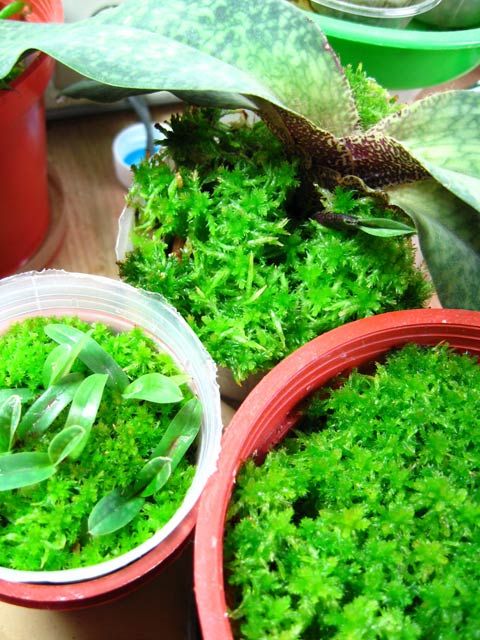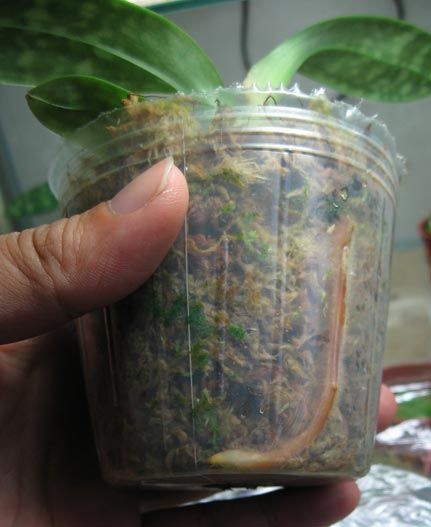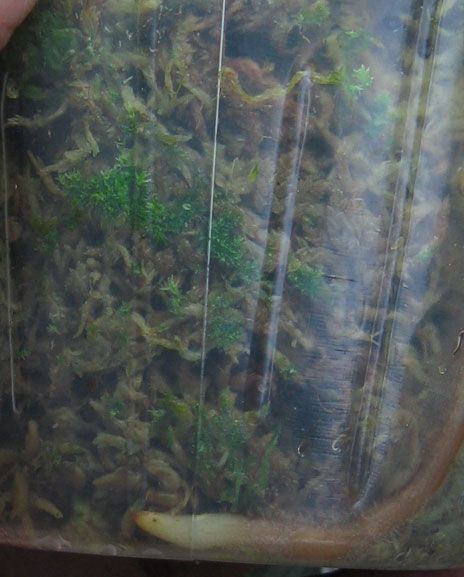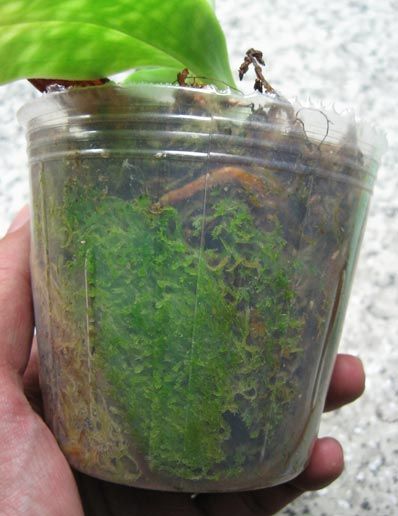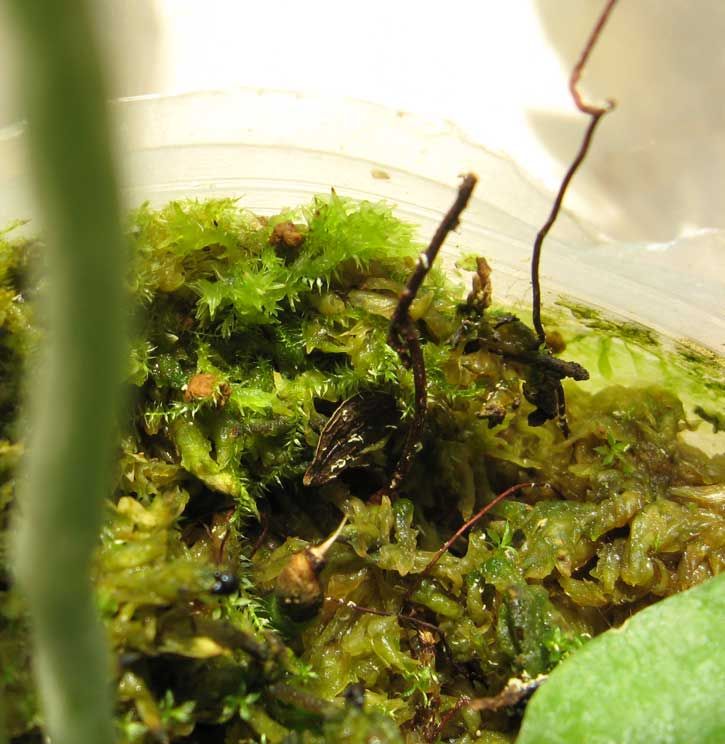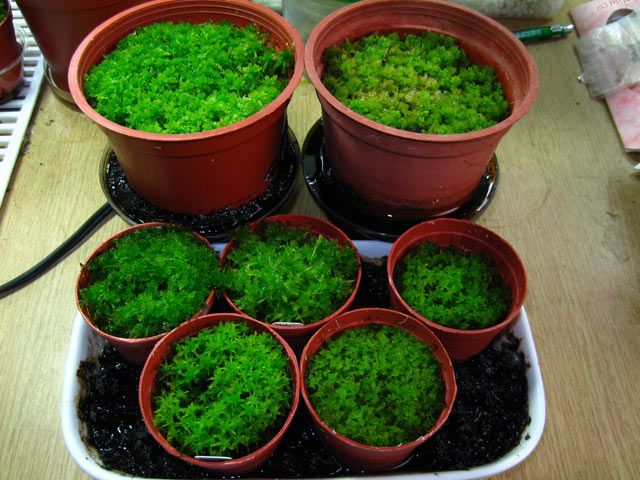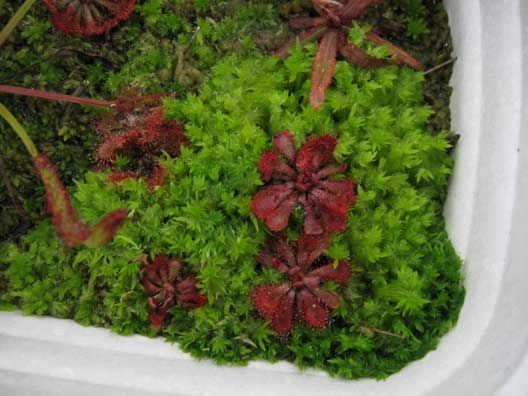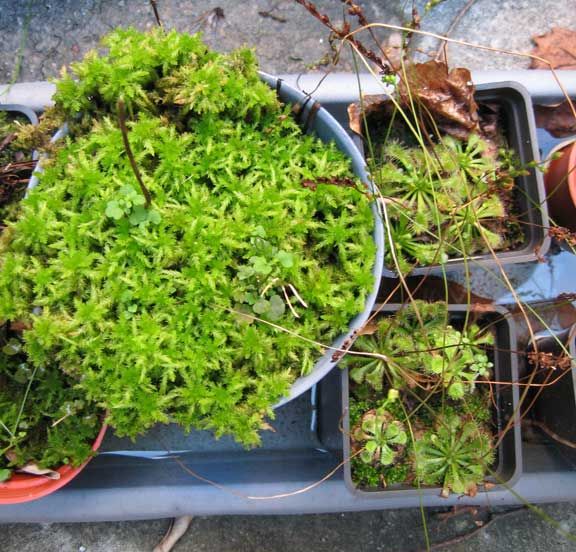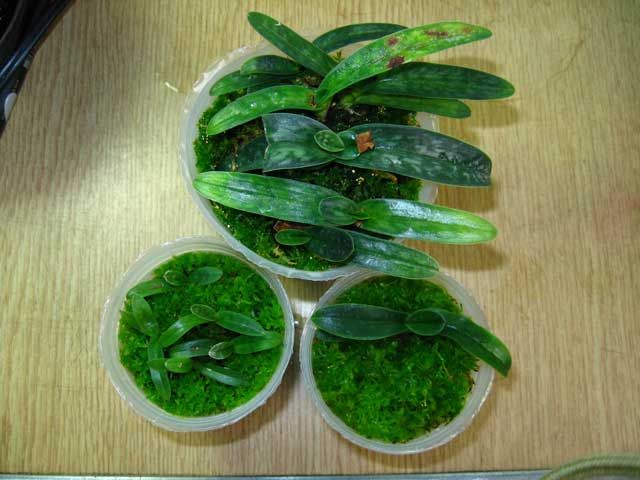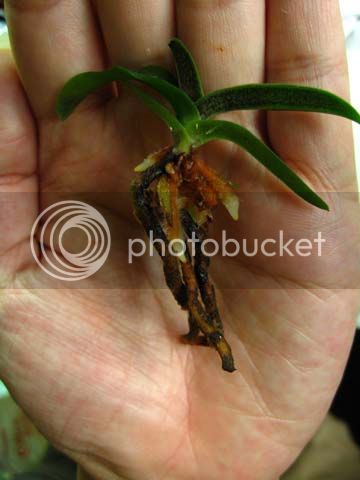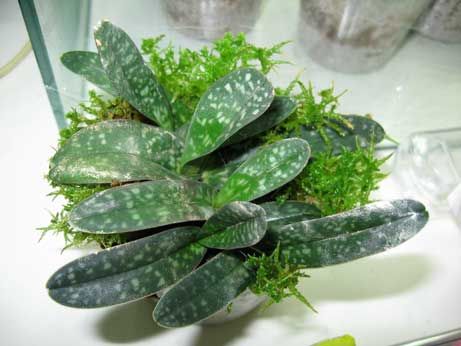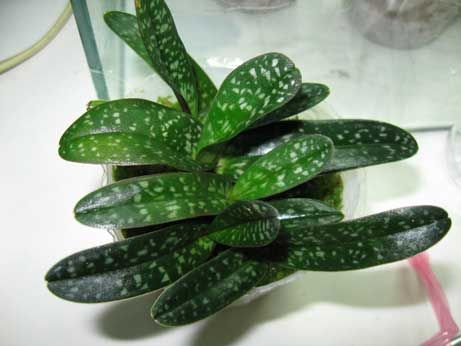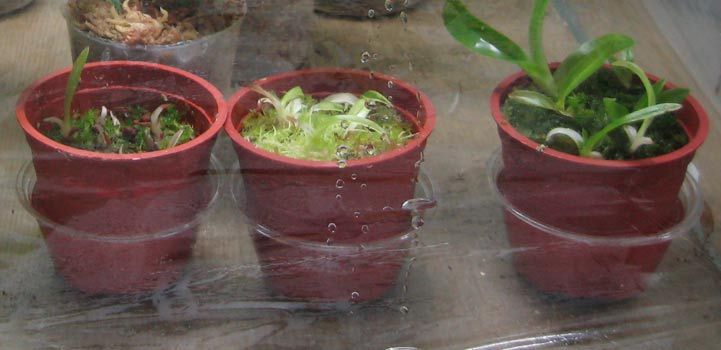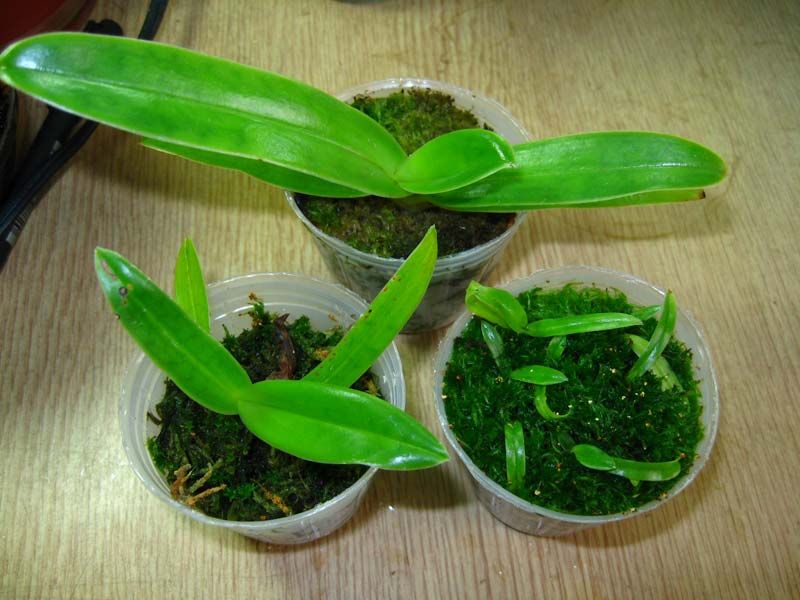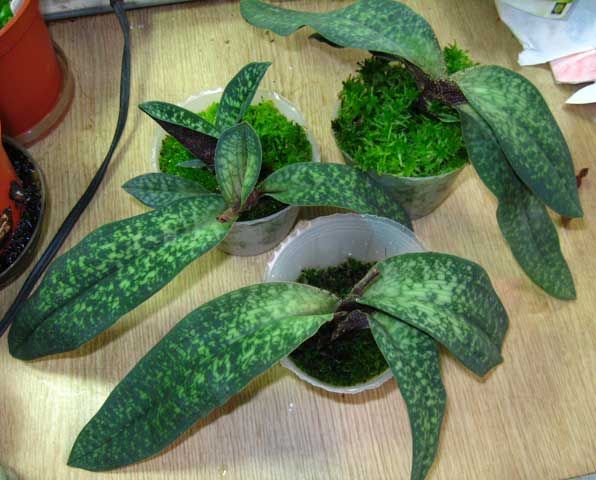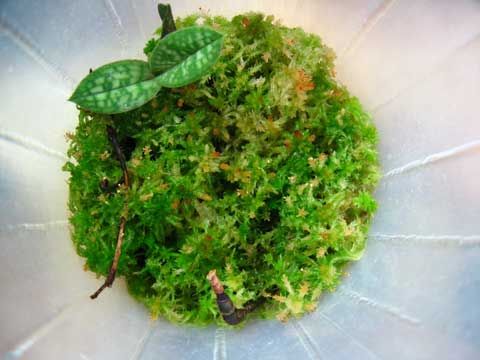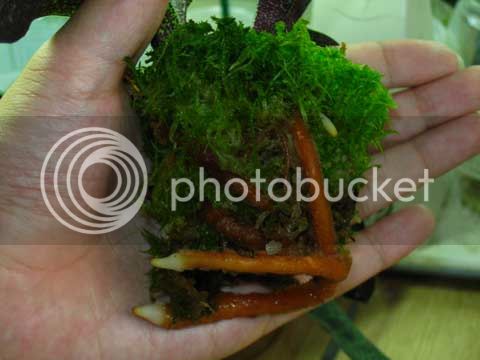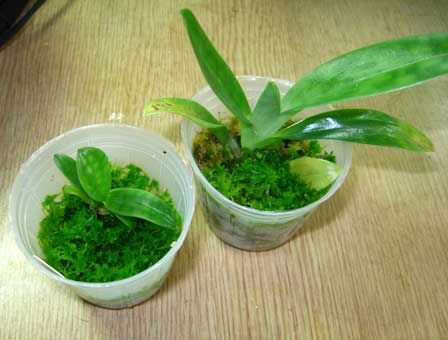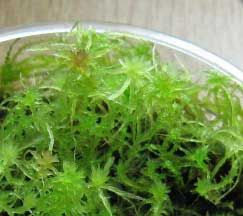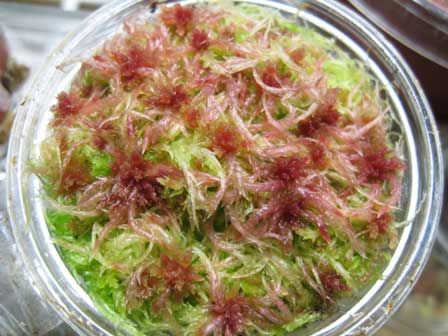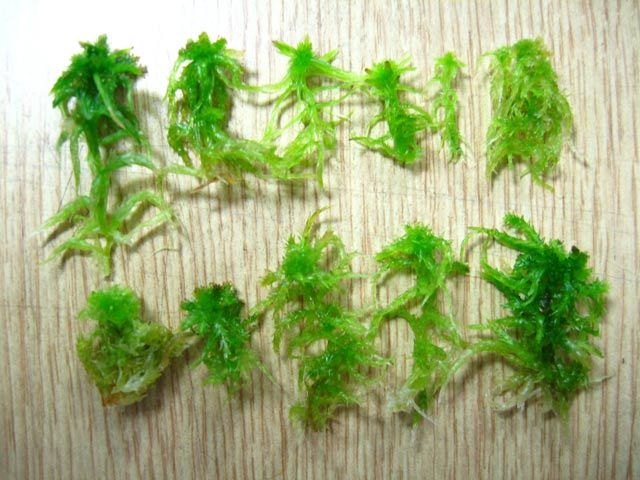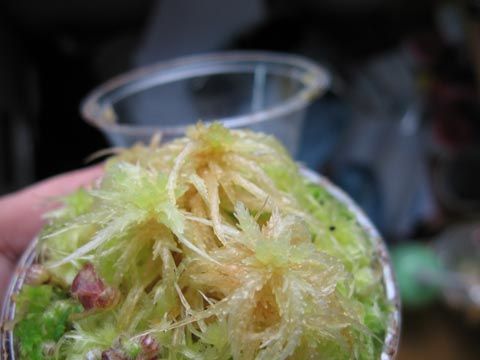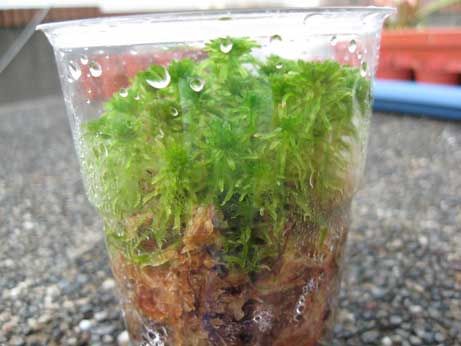Using live sphagnum as a medium for paphs
Lance Birk has stated before that sphagnum moss is magic stuff for paphs. I've
found this to be so true. I can keep the bases of paphs sopping wet yet
they seem to be protected from rots, and the live moss quicky promotes an
initial flush of root growth. That's why I think it is one of the best growing
medium for salvaging a paph. From mature division, newly deflasked seedlings,
to ailing plants, they seem to respond similarly to live sphagnum. Of course
we can save our paphs in a variety of growing media, but we can keep them
sopping wet with little fear of rot in live sphagnum, which is a great advantage
for plants with little or no roots on them.
I harvest my sphagnum moss for use by cutting a few centimeters off my
sphagnum lawn, leaving the bottom one or two centimeters of stumps, which
can sprout again. When potting the paphs, I try to keep the vertical
orientation of the capitula. Both loose or firmer potting can work quite well.
After potting, I either dunk the pots in shallow clean water, or frequently
water the moss. I usually fertilize my paphs by soaking the medium with 1/6
to 1/10 recommended concentration of fertilizer, but drenching live
sphagnum with this fertilizer solution kills it in a matter of days. When the
moss has grown too tall, I simply press the capitula down to a lower level in
the pot.
My first example is a group of Paph thaianum seedlings. I first grew them into
the usual sphagnum moss medium with wet to moist cycles, yet they did not
do very well, and some leaves began to rot. I consulted the nurseries I
bought my flasks from and they both confirmed that Paph thaianum is a
difficult one from flask. I quickly transferred them to live sphagnum after a
few months of very poor growth and they quickly recovered.
Newly repotted into live sphagnum. Note the damaged leaves due to rot in the larger compot.
Good root growth few weeks after transfer to live sphagnum.
How the large compot looks today. It has been grown in live sphagnum a
little more than a year. It's been kept in very wet conditions. Note how the
moss has grown rampant. It wicks water up the leaves causing some salt
deposits on them. Time to press down the sphagnum and rinse the plants!
At almost two years from flask, the largest of the lot have leafspans of 3 to 4 inches.
I've also tried live sphagnum for growing Paph sanderianum seedlings. They
responded very well, producing healthy growth in the next one or two years.
I had one seedling losing all its roots due to careless deflasking. After two
weeks in live sphagnum, it grew four roots about 1-cm long. That's what I
call magic! I've salvaged the smallest sanderianum flasklings this way too.
I divided a four-growth, one-stolon Paph. Fanaticum, which had been grown
in a bark mix, into 3 divisions and single stolon, and I repotted them in live
sphagnum. The old roots adapted well to the new medium, and they grew
really nice new roots as well.
However, I think there is a caveat to using live sphagnum long-term for paph.
It is difficult to provide extra nutrients to the paph without killing the
sphagnum. It is actually possible to fertilize the sphagnum moss by very
light sprinkling of dilute fertilizer over the capitula, but these probably will not
be available to the paph anyway. Therefore, even though the roots of the
plants grow well, they will slowly be staved of nutrients, which may make it
unsuitable for long term culture. In an article in AOS magazine I believe, Disa
grows very healthy roots in live sphagnum but the shoots grow poorly. Also,
owing to the extreme acidity of live sphagnum, some paphs that prefer
neutral to slightly basic medium may suffer in it (mentioned somewhere in
ladyslipper.com). There's an article in an orchid magazine (forgot which one)
about the use of live sphagnum for paphs in Germany, where it's said the standard
complex type do not do well in it. I have not tried live sphagnum for standard
paph, but I find it to be quite unsuitable for maudiae-type seedlings. They
can grow beautiful roots initially, but shoot growth is very poor, much slower
than those seedlings grown in the usual sphagnum moss medium.
Growing sphagnum as a hobby in its own right
After getting to cultivate some live sphagnum I was hooked. I wanted to
learn as much as possible about them. The handbook provided by the
Bristish Bryological Society (one of the links above) was a great enabler for
me. I was intrigued by the colorful descriptions of the colored sphagnum
species. I soon noticed that the the dried Chilean sphagnum is mostly
brownish red, which I later found to be Sphagnum magellanicum, yet the live
moss I had kept were mostly green, just with the occasional pink tinge.
The handbook stated that bright light is necessary for the colors to come out,
but mine grown in full sun in the winter were just slightly pigmented. I was
intrigued so I tried to find information about them on the net. Luckily I found
a few scientific papers stating that a drop in nightime temperature to
cold conditions is mainly responsible to induce the coloring. Ah, so that is it!
But mine was still just lightly colored despite the cool winters here. One day I
had some excess NAA powder after dipping my rose cuttings, so I sprinkled
some on my S. magellanicum grown indoors. Voila! I got deep red sphagnum
in a few weeks! Yuppee!
For those of you who might want to know the growing conditions, this small
cup of sphagnum was grown in bright light (5-cm from fluorescent tube), in
an air-con room with 25 degrees minimum.
I got hooked even deeper, and exchanged some sprigs of sphagnum with a
couple of overseas friends online, so that at the peak of my craziness I had
11 distinct sphagnum.
Beautiful, aren't they? Unfortunately last year was a rough year for me. I had
to relocate and stuff, and most of these didn't survive. Well, I've lost many
plants under my care, but my lost sphagnum is among those I miss the most
and feel quite bad about.
Finally, here's a highly enabling link about the sphagnum species from Britain:
http://hosting.sleath.co.uk/bbs/mosses_nz.php
Phew! That's the looongest post I have ever written in a forum. Hope you have enjoyed reading it! Cheers.
(Reposted with updated photo hotlinks, upon Delilah's request)




